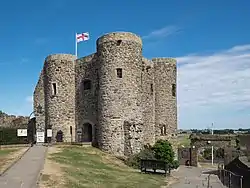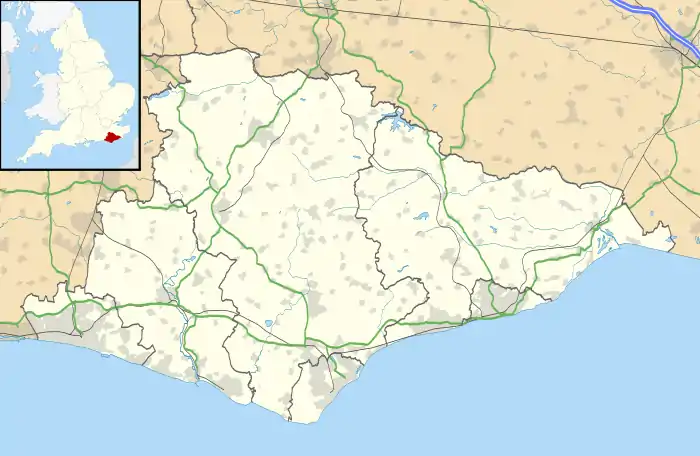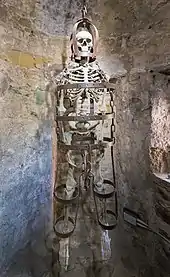Rye Castle
Rye Castle, also known as Ypres Tower, was built in the 13th or 14th centuries,[1] and is situated in Rye, East Sussex, England. It is a Grade I listed building and has been scheduled as an ancient monument.[2][3]
| Rye Castle | |
|---|---|
| Part of the City of Rye | |
| East Sussex in England | |
 The Ypres Tower | |
 Rye Castle Location in East Sussex | |
| Coordinates | 50°56′59.35″N 0°44′8.11″E |
| Type | Castle |
| Site information | |
| Open to the public | Yes |
| Condition | Standing |
| Site history | |
| Built | 1249[1] |
| Built by | King Henry III |
| In use | 1249- |
History
The exact date of construction is unclear although the possibility of creating a castle at Rye was mentioned in documents of 1226 and 1249.[2] In 1329 Murage was applied for and works carried out during the 14th century before and after attacks by the French.[2] Rye became one of the cinque ports and was involved in both defence and trade.[4] It was originally called "Baddings Tower".[5][6][7]
The castle may have been used as a prison and in 1430 became the property of John de Iprys; which lead to the name Ypres Tower.[2] In the 16th century it was used as a prison and courthouse with a full-time gaoler being appointed in 1796.[8] An exercise yard was added and then a women's prison in 1837.[9] The prison function continued until 1891.[2] It then became the town's morgue.[10]
The tower was damaged during air raids in World War II and has been repaired and restored since then.[2]
Architecture

The three-storey castle is of iron-stained sandstone. It has a square plan with a round towers at each corner. The door in the north side is protected by a portcullis.[2]
Rye Castle Museum
Ypres Tower is one of two sites of Rye Castle Museum and is a grade I listed building.[2] Exhibits in the tower include locally-made medieval pottery, an embroidery depicting many aspects of Rye life and history, medieval artifacts, activities and town maps.
The East Street Site, a former brewer's bottling factory, is the main exhibit area for the Rye Castle Museum. Opened in 1999,[11] the local history exhibits include fire fighting equipment, trade changes caused by the sea's retreat, maritime history and shipbuilding, antique toys and games, photos, town seals, and archaeological artifacts.[12][13]
References
- "CastleXplorer - Rye Castle". CastleXplorer. Archived from the original on 19 February 2012. Retrieved 31 December 2018.
- Historic England. "THE YPRES TOWER (1251521)". National Heritage List for England. Retrieved 27 July 2014.
- "Ypres Tower and part of Rye Town Wall -Scheduled ancient monument". National HeritageListfor England. Historic England. Archived from the original on 6 July 2019. Retrieved 8 March 2020.
- "The History of the Cinque Ports". Rye Museum. Retrieved 8 March 2020.
- "Rye Ypres Tower". Gatehouse. Archived from the original on 10 September 2016. Retrieved 8 March 2020.
- "Ypres Tower". Pastscape. Historic England. Archived from the original on 29 September 2017. Retrieved 8 March 2020.
- "Rye and Winchelsea". eCastles. Archived from the original on 11 August 2019. Retrieved 8 March 2020.
- "Rye Historic Character Assessment Report" (PDF). West Sussex. p. 25. Retrieved 8 March 2020.
- "Womens' Tower, former prison cells and exercise yard - Listed Building". National Heritage List for England. Historic England. Retrieved 8 March 2020.
- "Rye Castle and Town Defences". Castles Forts Battles. Archived from the original on 10 March 2019. Retrieved 8 March 2020.
- East Street Site Archived 30 January 2010 at the Wayback Machine
- "Rye Castle Museum (East Street)". Visit 1066 Country. Retrieved 8 March 2020.
- "Rye Castle Museum". England Rover. Retrieved 8 March 2020.
External links
 Media related to Rye Castle at Wikimedia Commons
Media related to Rye Castle at Wikimedia Commons- Official website